

Damion Smy
Boxy new KGM Musso unveiled to take on HiLux and Ranger ahead of Australian launch
8 Hours Ago
The iconic G-Wagen has gone electric. Angus MacKenzie gets a first drive of Benz's new electron-powered 4WD to see if it fits the mould.

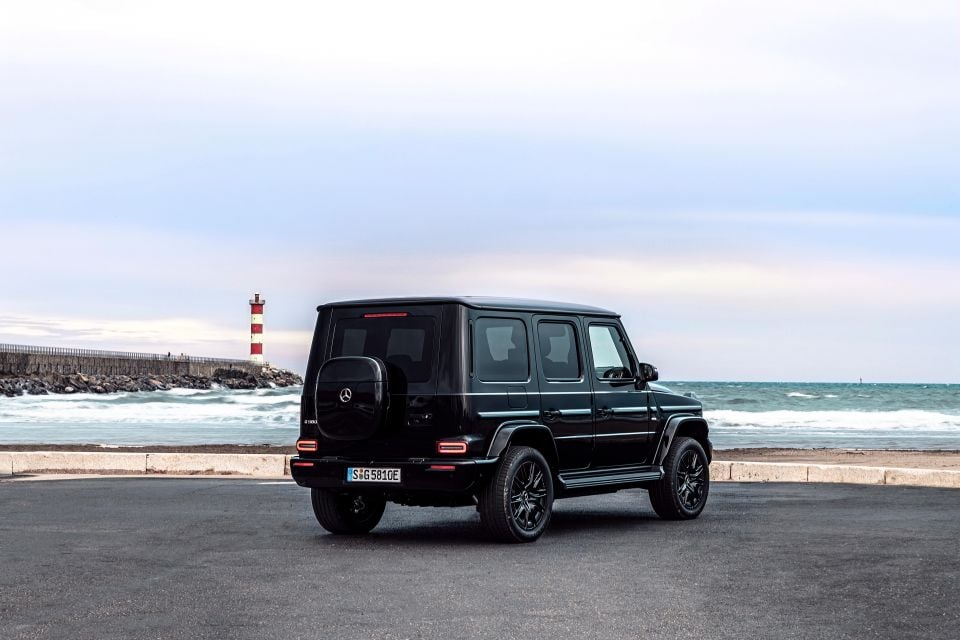

Spare a thought for the engineering team tasked with developing the first ever electric-powered G-Wagen – the 2025 Mercedes-Benz G 580 with EQ Technology.

The G 580 combines one of the three-pointed star’s most iconic and profitable vehicles with cutting-edge powertrain technology that has yet to win overwhelming acceptance from most consumers. It was an idea that could have easily gone very wrong.
With that in mind, the G 580 development team approached the task with one key thought, says Manuel Urstöger, the engineer with overall responsibility for the G 580’s battery electric powertrain. “The G must be a G. That was what was most important to us.”
The electric G had to be able to climb steep slopes, tiptoe over big boulders, plough through mud, storm sand dunes, and wade through deep water. In short, it had to be able to go anywhere a regular G could go, with no compromise.
The G 580 – we’ll dispense with the rest of the clunky name from here on in, as even Mercedes insiders admit owners will just call it the ‘G 580’ – looks pretty much like any other of the current G-Wagen (aka G-Class) models.

The standard grille is the same as that on the recently refreshed G 450d diesel and G 500 petrol models, but a more aerodynamic black panel grille with an LED light frame is available as an option.
Look closely and you’ll notice several detail changes. The bonnet has been reprofiled to clear the EV powertrain hardware. Vents in the flares over the rear wheel arches help create air curtains around the rear wheels.
Other aero tricks include smoother cladding around the A-pillars, as well as a small spoiler between the seam and top of the windshield and the leading edge of the roof.
These features were both developed for the electric-powered G-Wagen, but adopted on the facelifted internal combustion engine models.
As the G 580 is not expected to arrive in Australia until late this year or early 2025, Mercedes-Benz Australia has yet to announce pricing.

However, in Germany the G 580 costs 24.6 per cent less than the refreshed AMG G 63, which indicates an Australian drive-away price of around $290,000.
The G 580 First Edition, a highly optioned model that will be available only in the first year, will likely cost about $390,000 – but, we’re just making an educated guess
Buy your new car without the stress. It's fast, simple and completely free.

Great service from Travis and team, second time I have used this business would not hesitate to recommend them to anyone
Craig C.
Purchased a Ford Ranger in Sunshine Coast, QLD
CarExpert helped Craig save thousands on his Ford Ranger, now let us save you on your next new car.
Find a dealThe G 580’s interior is identical to that of the internal combustion engine G-Class.
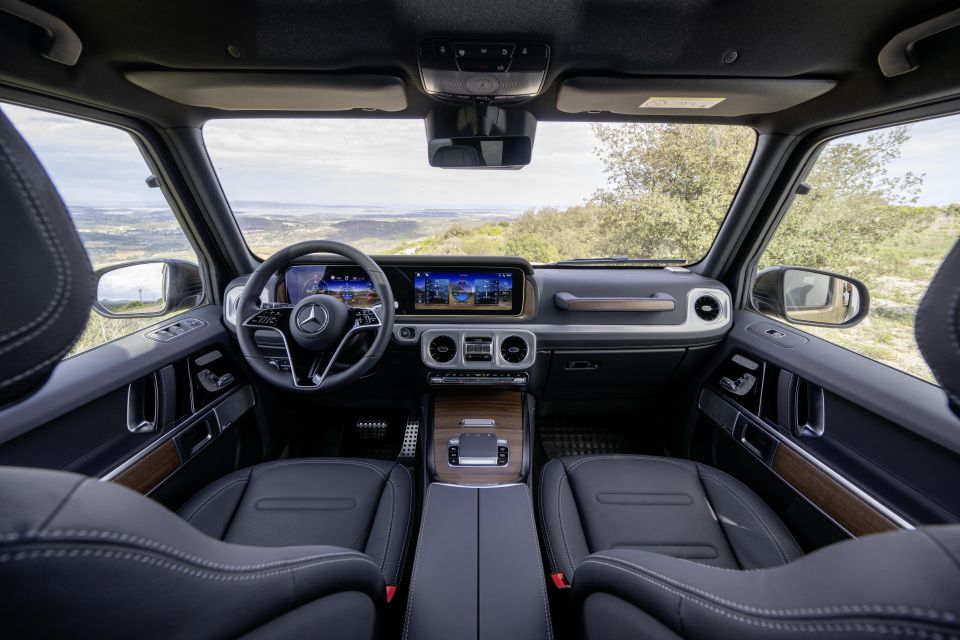
That means it is equipped with the latest generation of the MBUX digital architecture with a dual-display unit incorporating digital cluster an infotainment display stretching across 50 per cent of the dash.
The digital dash is fully configurable, and the display at the centre of the dash is now a touchscreen.
Standard equipment includes leather-trimmed seats and open-pore walnut on the dash and doors, plus heated and cooled cupholders and a wireless smartphone charging pad. Options include a rear seat entertainment package with two 11.6-inch touchscreen displays.
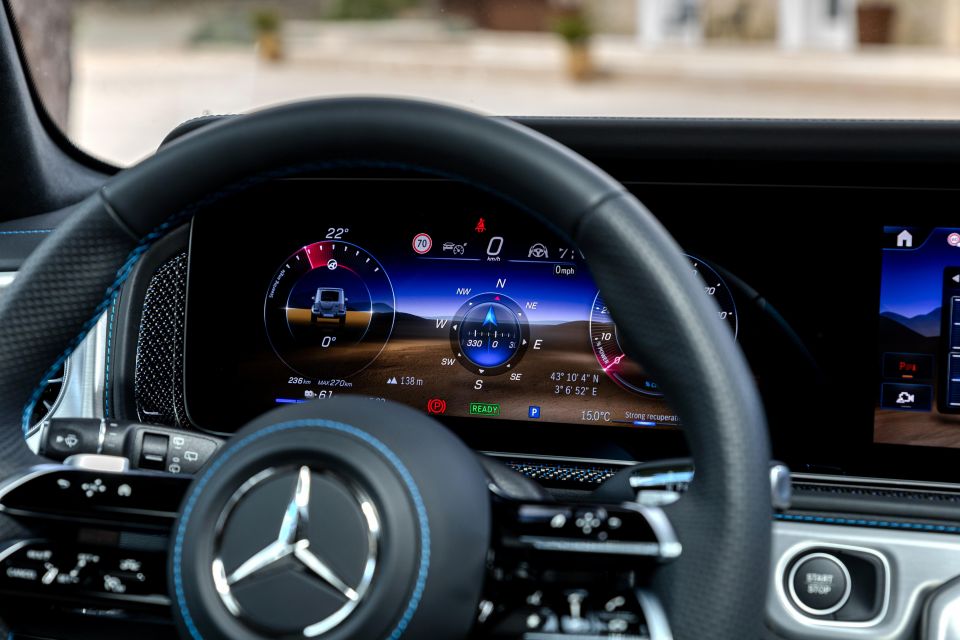
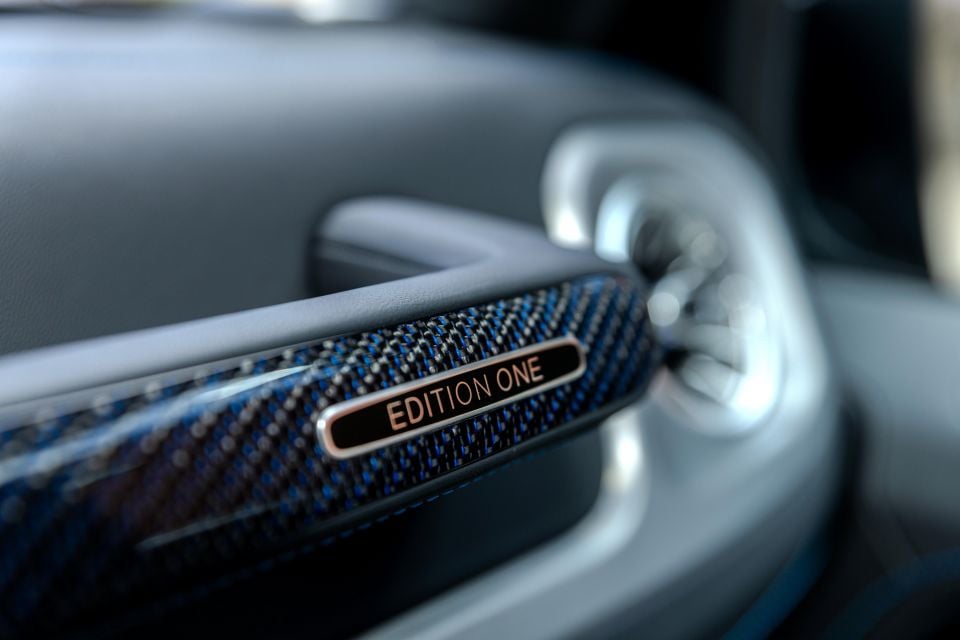


One difference between the G 580’s interior and those of the internal combustion engine G-Class models is visible at the centre of the dash, between the two air vents above the centre console.
Instead of the three buttons that lock the centre, rear, and front differentials, the G 580 has a button to engage low range, flanked by buttons with a graphic of the G flanked by arrows.
These are the first clues the G 580 is the most radically different G in the 45-year history of a vehicle originally designed in the mid-70s to be as good on the road as a Range Rover, and as tough and capable off it as a Toyota LandCruiser.
The G 580 is powered by four 108kW e-motors that deliver a total system output of 432kW and a thumping 1164Nm of torque.
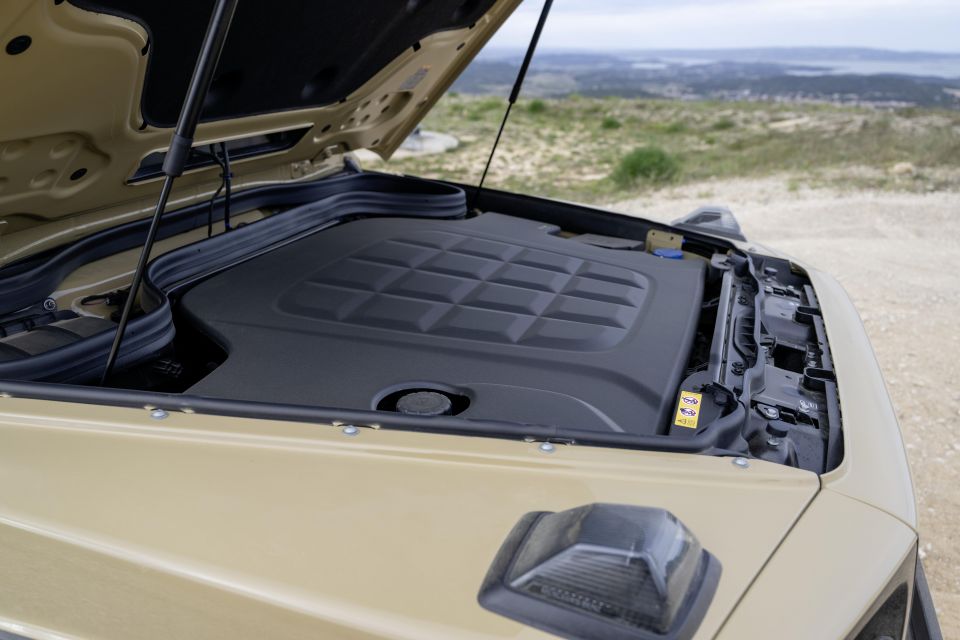
Powering the motors is a two-tier, 216-cell lithium-ion battery with a useable capacity of 116kWh. The battery will accept charge rates of up to 200kW on a fast charger, meaning it can be taken from a 10 per cent state of charge to 80 per cent in 32 minutes.
Because the G 580 had to look like a regular G-Class, all that powertrain hardware had to fit within the same physical envelope as the ICE models. The fact the G-Class is built on separate chassis proved a key enabler.
The e-motors are ingeniously packaged, the pair at the front and the pair at the rear each sharing a common water-cooled housing that also includes the inverter hardware and a separate two-speed transmission for each motor.
In simple terms, each e-motor sits above its transmission and outputs drive to the wheels. The e-motor on the right-hand side of the housing drives the left-hand wheel, and vice-versa.
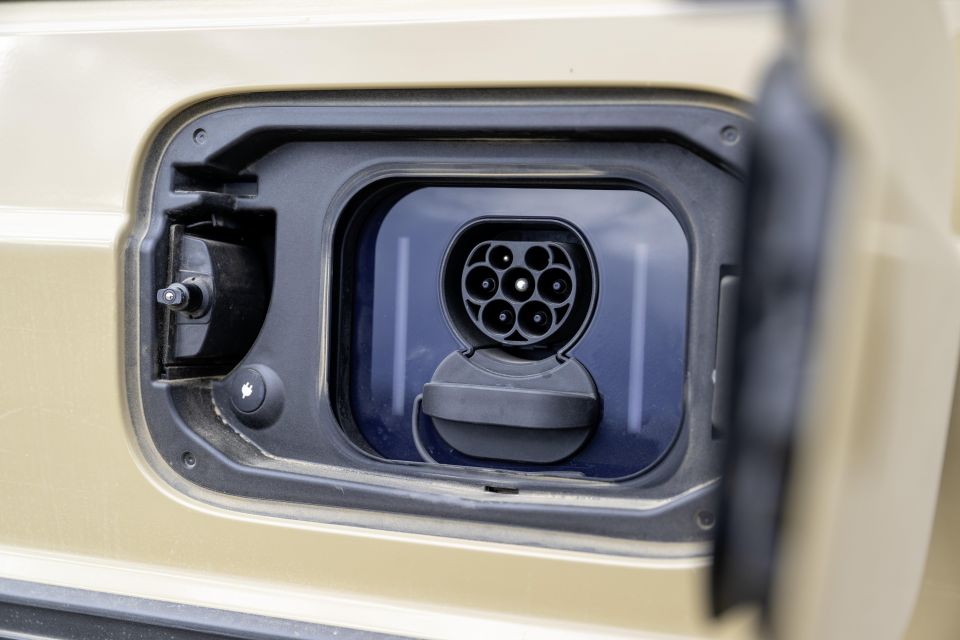
The two-speed transmissions give the G 580 a genuine mechanical low range, with a 2:1 ratio compared with the 1:1 of the high range. Why go to all that complexity, and add cost? Capability and durability, says Manuel Urstöger.
“Electric motors do not like to be kept at low rpm, as they generate a lot of heat,” he says. The low-range gear enables the G 580’s e-motors, which are also internally oil cooled and rev to 14,400rpm, to spin faster at low vehicle speeds, keeping them even cooler and prolonging their life.
To ensure it can the survive the punishment of extreme off-roading – even though G Class engineers ruefully admit 99 per cent of customers never take their vehicles off-road – the battery is enclosed in an ultra-stiff, torsion-resistant casing that is also waterproof, allowing the G 580 to wade through 850mm of water – 150mm more than internal combustion engine models can manage without a snorkel.
The battery casing is further protected by a 25mm thick carbon-composite skid plate attached to the frame by 50 steel screws. The skid plate alone weighs 57kg, but Manuel Urstöger says a steel skid plate offering similar levels of protection would have weighed three times as much.
Mercedes-Benz claims the G 580 will zoom from 0 to 100km/h in 4.6 seconds on the way an electronically limited top speed of 180km/h.

Though the G 580 can’t match the 220km/h top speed of the AMG G 63, it is – on paper – barely half a second slower from 0 to 100km/h than AMG’s madcap off-roader. On the road, that gap feels even smaller.
That’s because the four-motor electric G-Class catapults forward the moment you punch the accelerator from a standing start, weapons-grade torque and astonishing traction momentarily compensating for the fact that, at 2995kg, the G 580 weighs a hefty 445kg more than its thundering V8-powered sibling.
That extra mass, combined with less aggressive wheels and tyres, and the fact the G 580 doesn’t have the trick new Active Ride Control suspension of the facelifted AMG G 63, means the electric G isn’t as quick through the twisties as the AMG version.
But there’s not much in it.
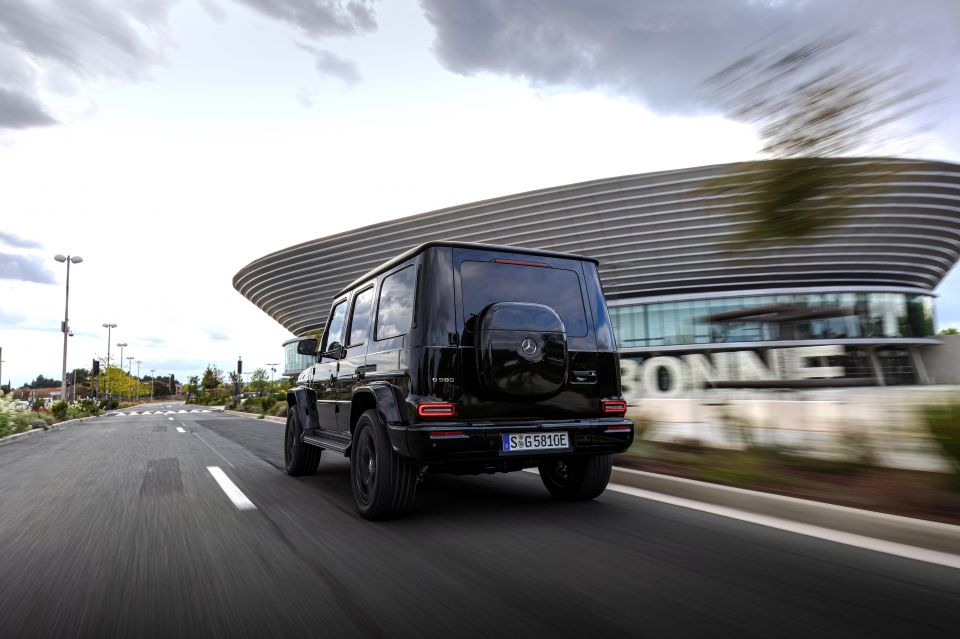
The G 580 offers three on-road drive modes: Comfort, Sport, and Individual. Comfort is the default drive mode, which also sets the adjustable regen to ‘D-‘ – the second highest level.
In Sport mode the G 580’s powertrain management system delivers much more rapid response to accelerator inputs, stiffer suspension, and heavier steering. It also enables torque vectoring across the front axle to help get the big off-roader into and out of corners.
This, and the instant-on response from the powertrain, makes the G 580 feel remarkably agile for a vehicle of its size and mass.
Sport mode amps up the volume of what Mercedes calls G Roar, an artificial soundscape played through the audio system that rises and falls with road speed in the on-road driving modes.
We normally don’t like such gimmicks on EVs, preferring to turn them off and waft along in silence, but the G Roar’s muted G 63 rumble was surprisingly engaging.
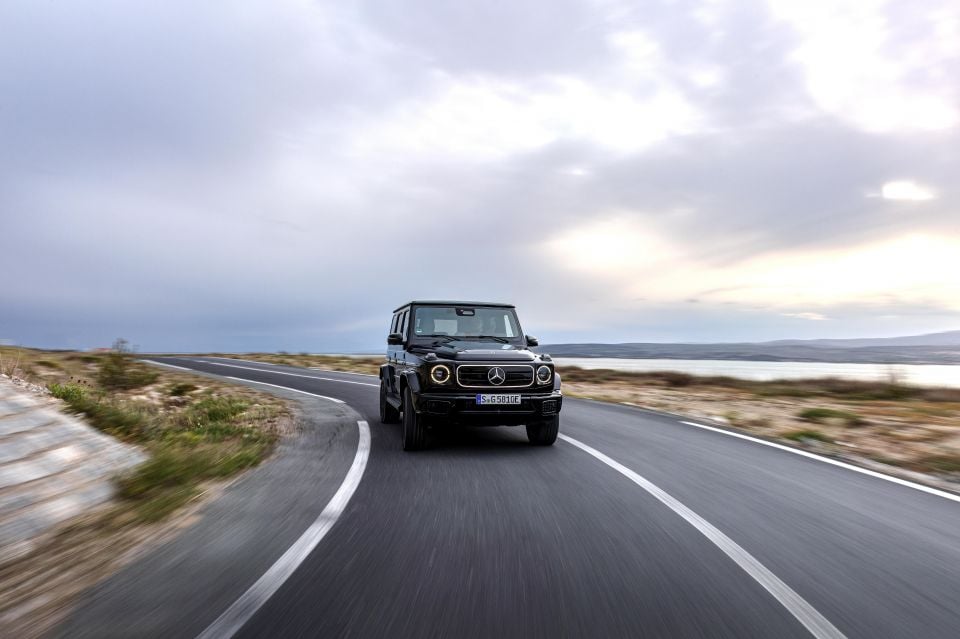
The size and shape of a small barn, the G 580 is never going to slip through the air.
But with the optional aero grille and on the standard 18-inch wheels, the various aero tweaks have resulted in a drag co-efficient of 0.44 – a 17 per cent improvement over the pre-facelift G 63.
Wind noise is surprisingly low, as is tyre noise. The G 580 is almost luxury car quiet.
Like the other G Class models, the G 580 has a multi-link independent front axle, and a non-independent axle at the rear for maximum articulation in extreme off-road conditions.
Having an e-motor power each wheel is straightforward with an all-independent suspension setup; but combining e-motors with a non-independent rear axle required some lateral thinking.
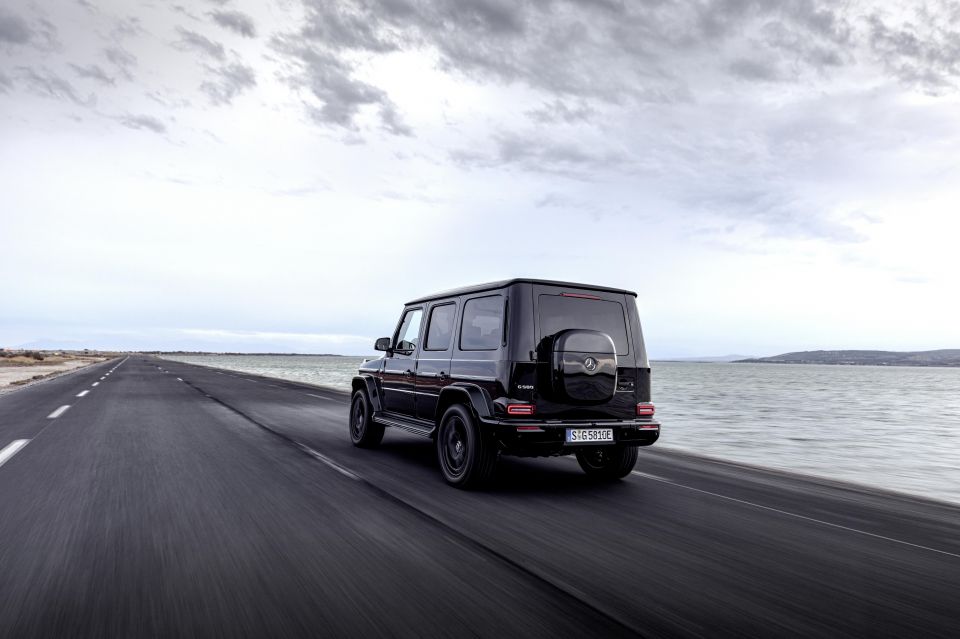
The solution is an engineering concept 130 years old: the De Dion axle.
The De Dion design features a rigid tube connecting the wheel hubs. So it behaves like a solid axle, but the drive to each wheel is via separate half-shafts with universal joints on either end. That allows the e-motor housing at the rear of the G 580 to be bolted securely to the chassis.
The G 580’s ground clearance is 250mm, with the 2890mm wheelbase giving it a breakover angle of 20.3 degrees. Approach angle is 32 degrees and departure angle is 30.7 degrees. By way of comparison, the regular G-Class has an approach angle of 30.9 degrees, a departure angle of 29.9 degrees and a breakover angle of 23.5 degrees.
We were given the opportunity to test the G 580’s off-road capabilities on trails near Perpignan in the south of France. It’s rocky and steep terrain, the sort of stuff that could easily stop a Toyota LandCruiser, Land Rover Defender, or Jeep Wrangler, and had been made more challenging during our session by days of soaking rain – but the G 580 ate it up.
Two off-road drive modes are available. Trail optimises the drive train for gravel roads or tracks. Rock sets the powertrain up for hard-core off-roading and allows you to select low range.

Low range is selected via pushing the central of the three buttons on the dash, and allows drivers to activate an intelligent crawl function, a sort of ultra-low speed cruise control.
Slow crawl restricts speed to 2km/h on level ground or downhill; variable crawl ups it to between 5km/h and 6km/h and allows the driver to increase the speed up to 15km/h on 10 to 20 per cent downhill slopes; fast crawl gives a maximum of 8km/h on level ground or while traveling uphill. Top speed in low range is 85km/h.
Switching between the crawl speed settings is done by clicking the steering wheel paddles, and the driver can override the system at any time with the accelerator or brake.
The trick – and this is hard if you’re an experienced off-roader – is to keep your feet away from the pedals most of the time. The G 580’s four e-motors allow such fast and ultra-precise control of the torque at each wheel independently, that the car’s brain is better than yours when it comes to finding traction.
On the steepest climbs the G 580 would almost come to a halt, like a free solo climber pondering their next move. And in a sense, that’s exactly what was happening – the e-motor driving each wheel was gently ramping up its torque output right to the limit of adhesion.

Where expert car reviews meet expert car buying – CarExpert gives you trusted advice, personalised service and real savings on your next new car.
Of course, while each e-motor is working independently, they are also working in unison to keep the Mercedes moving.
As a result, the G 580 has better traction in the rough stuff than any internal combustion engine off-roader, even ones with three lockable diffs like the regular G-Class.
What’s more, the software means the four-motor setup delivers all the advantages of lockable diffs, without the disadvantages – in other words, you get maximum traction and are still able to steer around corners.
On downhill sections the G 580 feels smoother and more progressive than any internal combustion engine off-roader with a hill descent control system. That’s because the speed is controlled by using the e-motors to directly control the torque at each wheel, and not by applying the brakes.
“E-motors are so much faster to react than brakes when coordinating themselves,” says G-Class chief engineer Fabian Schossau.
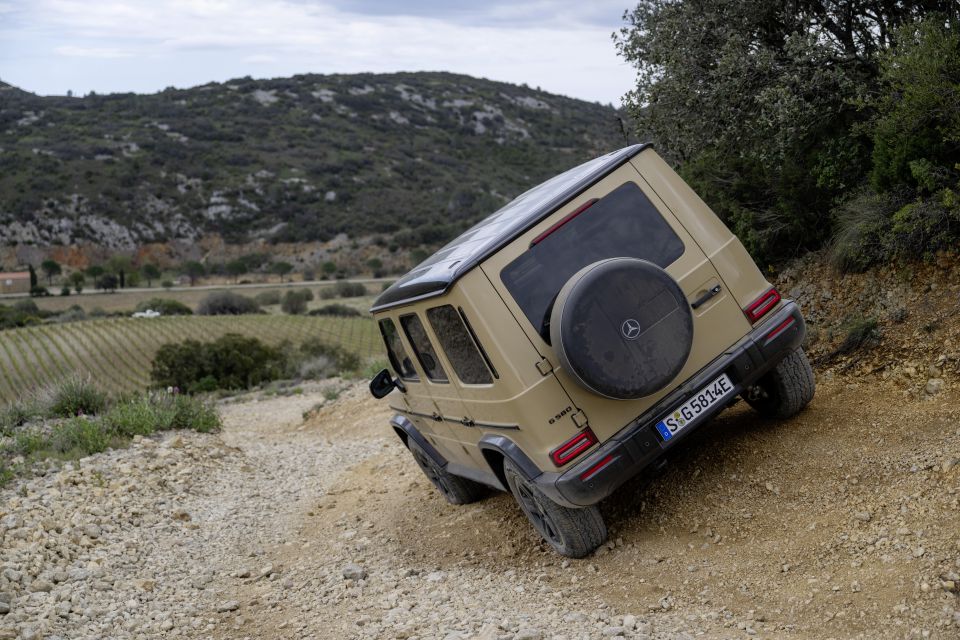
The same applies even when you use the brake pedal yourself. As in most EVs, braking up to 0.3g is done entirely via regen. On a downhill off-road section all braking is therefore done through the e-motors, all working together to make sure traction is always maintained.
The ability to individually control each wheel has enabled the G 580’s big party trick, the G Turn. In Rock mode low range with your foot on the brake, press the G Turn button,
Then, hold either the left- or right-hand paddle on the steering wheel, depending on which way you want the G 580 to spin – the front wheels must be pointing straight ahead. Then come off the brake and mash the accelerator.
With the wheels on one side being spun in the opposite direction to those on the other, the big Mercedes will rotate up to 720 degrees around its vertical axis. Move the steering wheel, touch the brake, release the accelerator or the paddle, and the G 580 will stop spinning instantly.
The G Turn’s real-word use is questionable: “There was a lot of discussion as to whether it was a gimmick,” Urstöger acknowledges, “but we decided it added to the capability.”


More obviously useful is G Steering function, which locks either the right- or left-hand rear wheel to effectively shorten the G 580’s turning radius and get it around tight corners.
Again, it’s only available in Rock mode and low range, but once activated will stay operational at speeds up to 25km/h.
The lower breakover angle meant G 580 did thump onto the under-battery protection plate a couple of times on obstacles over which the diesel-powered G 450d we drove was able to tiptoe. “Don’t worry,” said Fabian Schossau, “it won’t break. We’ve tried.”
The virtual locking diff effect of the powertrain’s instant torque vectoring meant the G 580’s steering didn’t have the nice mechanical feel of the G 450d’s.
We wonder whether the electric G’s not inconsiderable mass would leave in prone to being stuck on its smooth underbelly in soft, deep mud. But make no mistake: The G 580 is a breathtakingly brilliant hardcore off-roader.
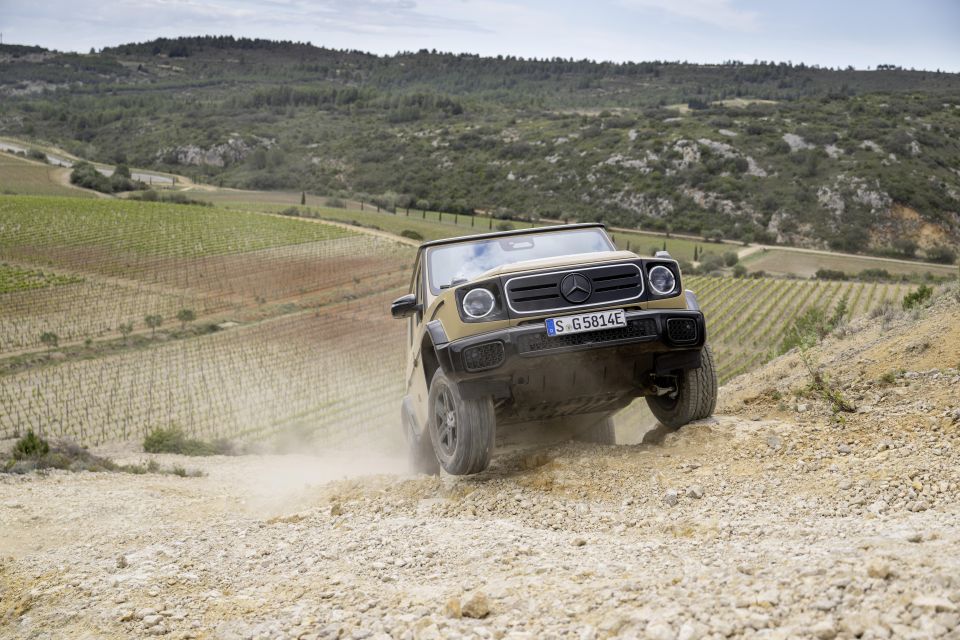
What we didn’t expect was to find it to be so jaw-droppingly fast and agile when being driven flat-out along a rally stage in Trail mode and high range.
Our driver, G-Class instructor Michael Weykopf, had the G 580 dancing like a 3.0-tonne WRC car sideways into corners, taking air over the jumps, and rocketing along rocky straights at Dakar-busting speed.
Even from the passenger seat, you could feel Weykopf had such precise control over power and torque and traction that he could pretty much place the G 580 where he wanted when he wanted.
It rammed home the point there probably isn’t a production 4WD in the world with the all-round capability of the Mercedes-Benz G 580 (with EQ Technology).
As the G-Class is one of Mercedes-Benz’s more expensive models, equipment levels are in S-Class territory.
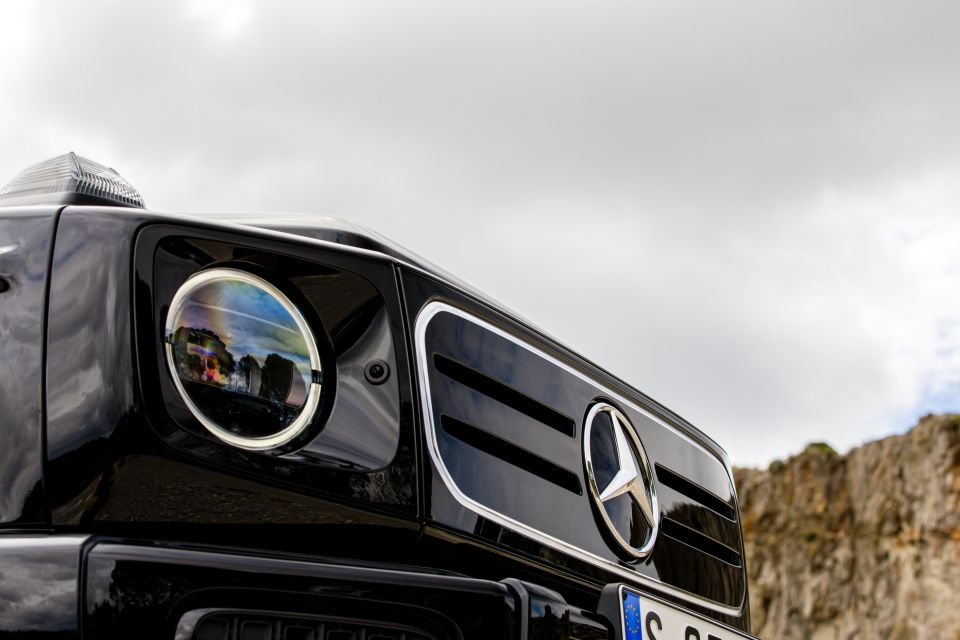
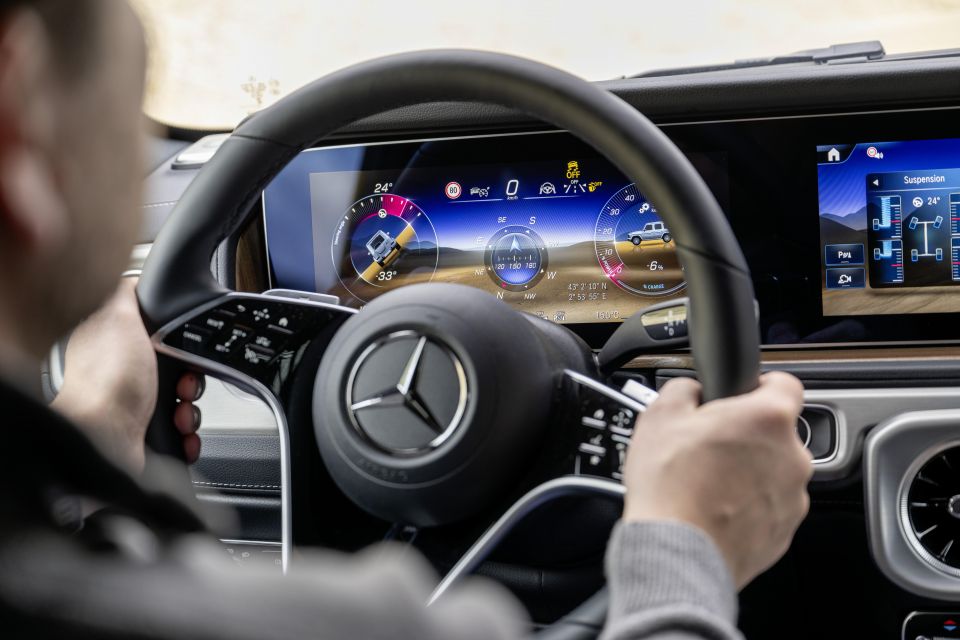
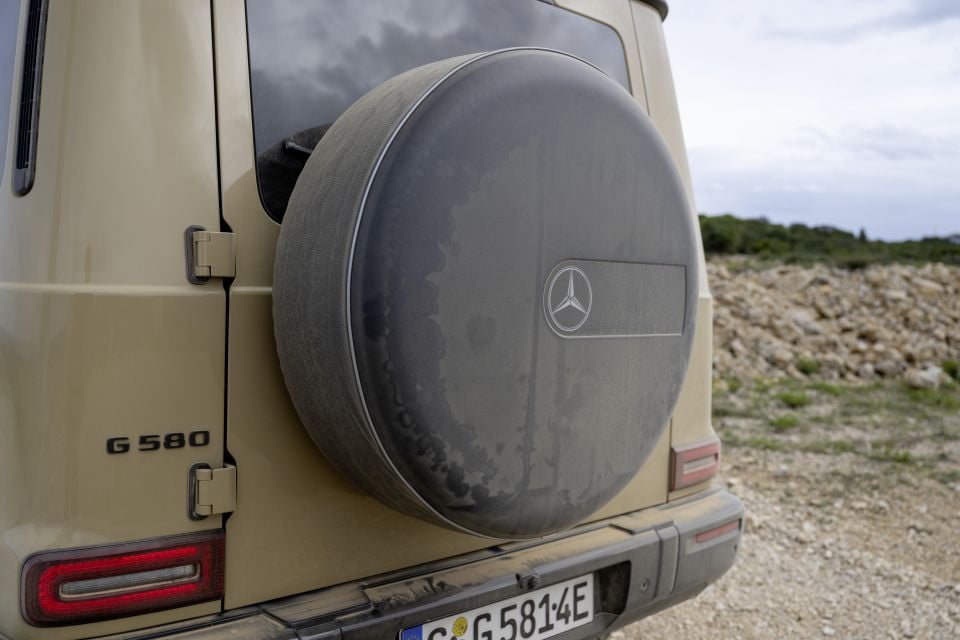
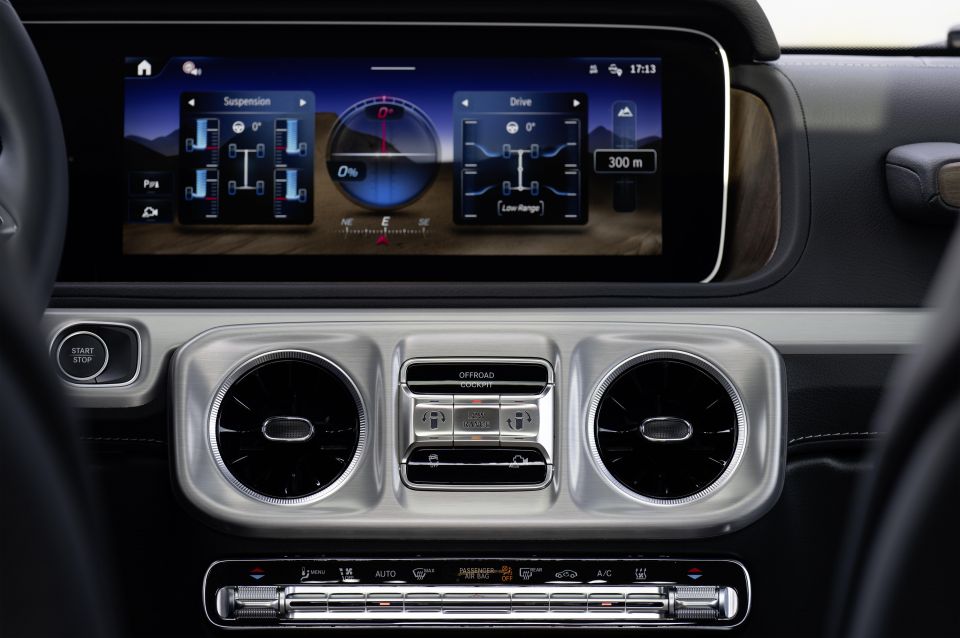
Standard features on the G 580 include:
Options include:
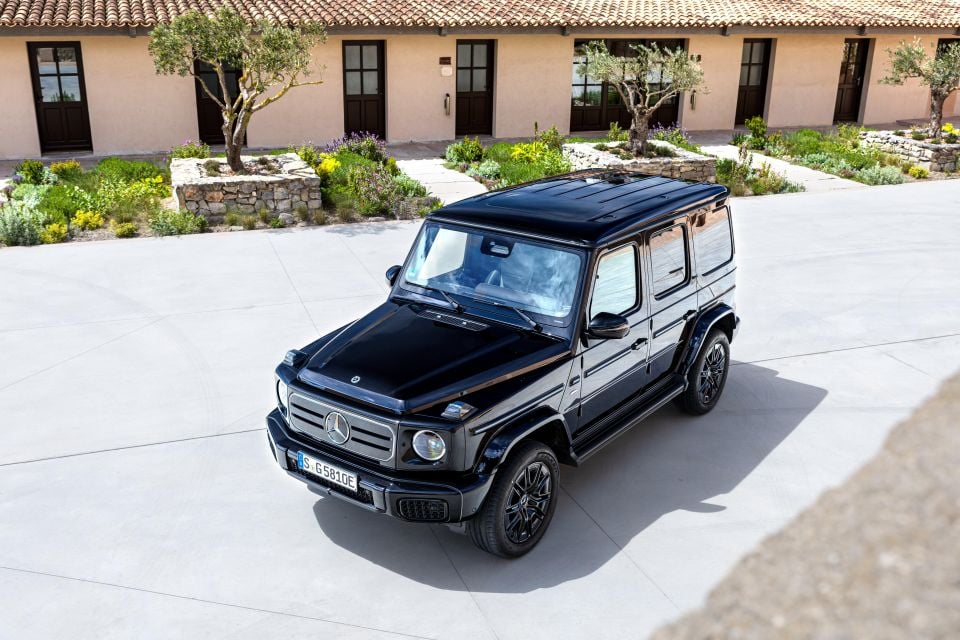
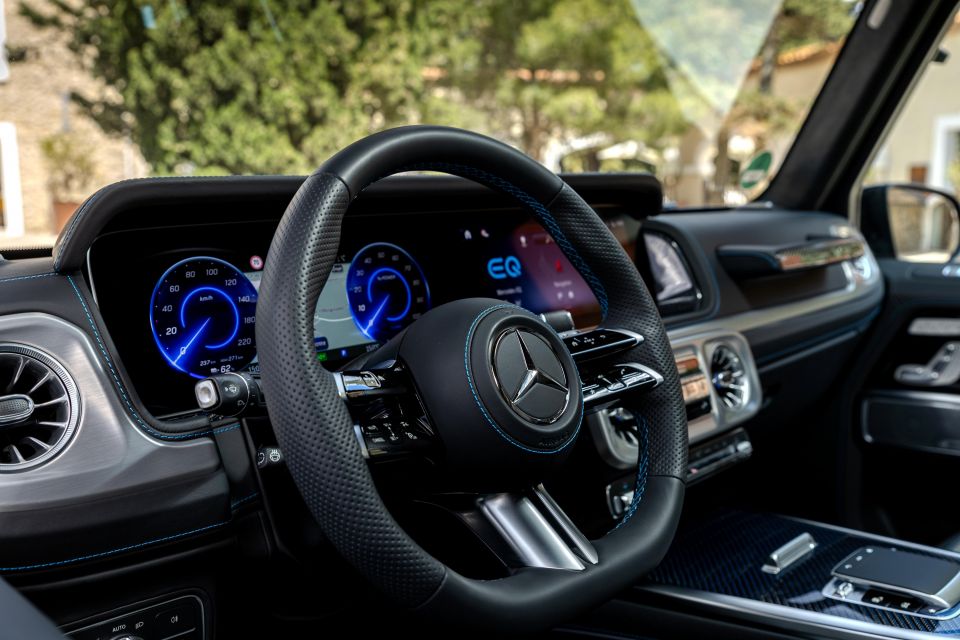
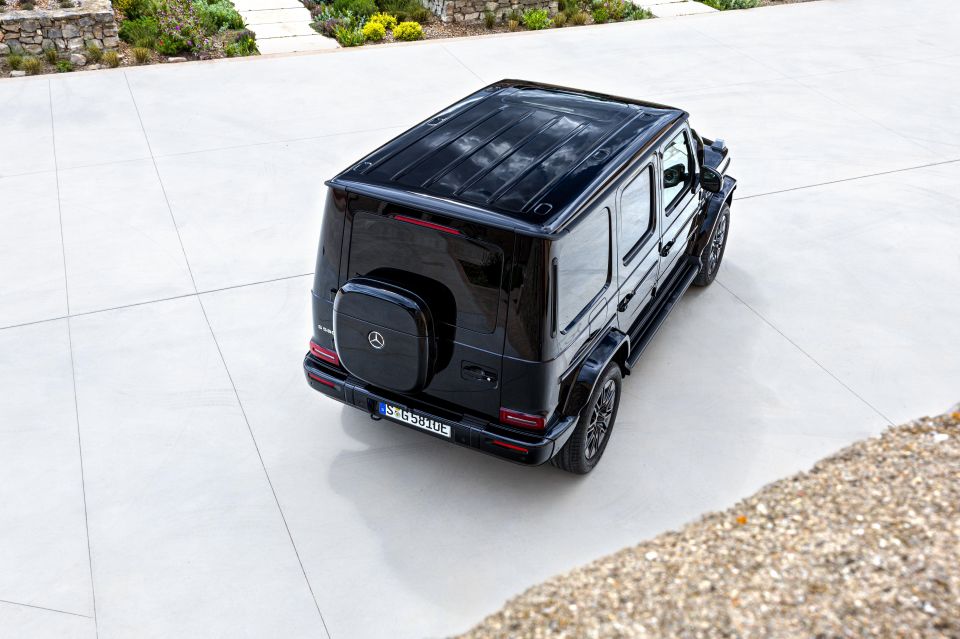

For the first year, Mercedes will offer an Edition One version of the G 580 that bundles together some of the most popular options, including the AMG Line and Night packages.
The Edition One will be available in five colours: South Sea Blue Magno, Moonlight White Magno, Moonlight White Metallic, Arabian Grey, and Obsidian Black Metallic. Unique styling details include a blue trim strip insert in the exterior protective moulding and blue brake calipers.
The Edition One’s interior is trimmed in Silver Pearl and Black Nappa leather with blue carbon-fibre trim elements and blue stitching.
The G 580 comes standard with the Mercedes-Benz’s arsenal of passive and active safety features – though the new-generation G-Class is currently unrated by ANCAP and Euro NCAP.

Standard safety features include:
Like other Mercedes-Benz vehicles, the G 580 will be covered by a five-year, unlimited kilometre warranty here in Australia.
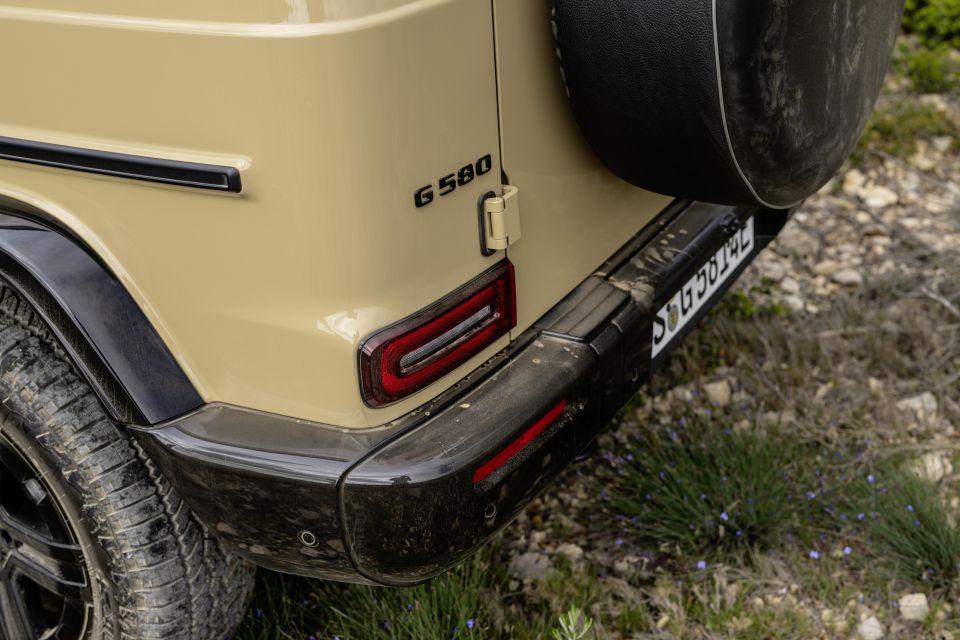
Service intervals are 12 months or 25,000km (whichever comes first), with service plans covering three, four and five-year terms.
Mercedes-Benz claims a G 580 on 18-inch road tires and fitted with the optional Black Panel grille achieves a range of 473km under the WLTP electric vehicle test protocol.
That suggests an energy consumption rate of 24.5kWh/100km. Assuming an average electricity cost of $0.30 per kWh, that means G 580 will use at least $7.35 worth of electricity every 100km.
The Mercedes-Benz G 580 is an utterly extraordinary machine.
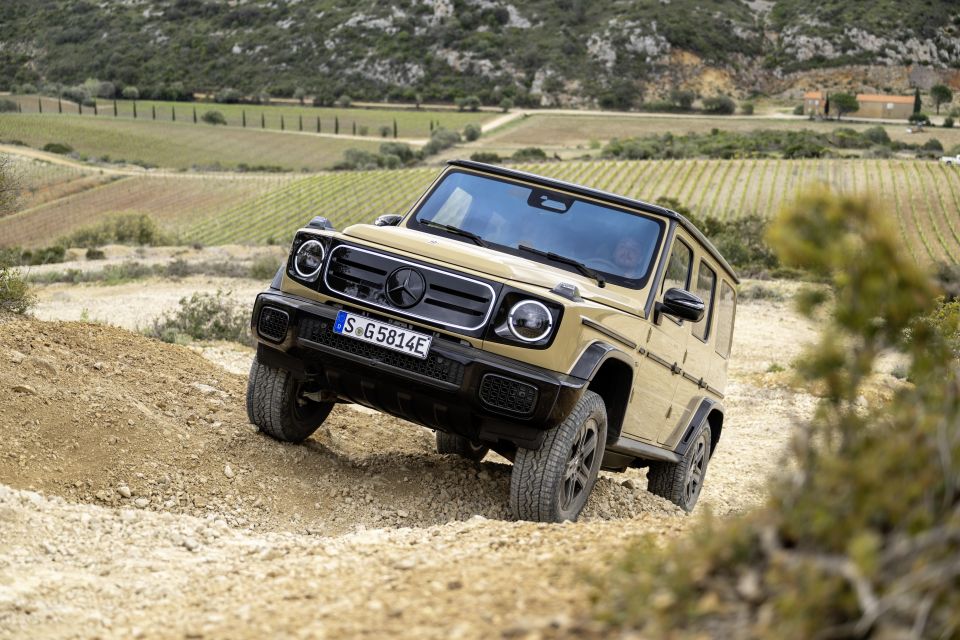
There are few internal combustion-engined vehicles that can match its combination of on road performance and off-road capability. In terms of electric vehicles, it’s in a class of its own.
And best of all, it’s still a proper G-Wagen.
Click the images for the full gallery
MORE: Buy a Mercedes-Benz G-Class MORE: Everything Mercedes-Benz G-Class


Damion Smy
8 Hours Ago


Damion Smy
10 Hours Ago


Damion Smy
11 Hours Ago


Damion Smy
13 Hours Ago


Damion Smy
14 Hours Ago


Damion Smy
16 Hours Ago